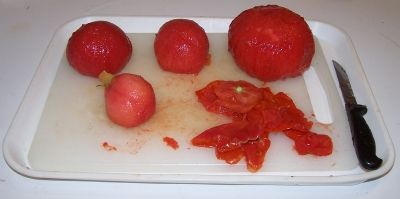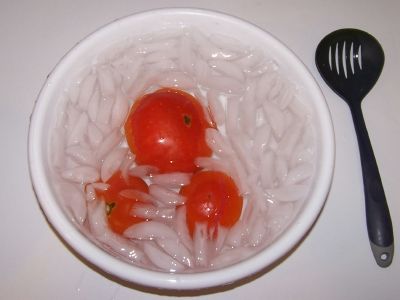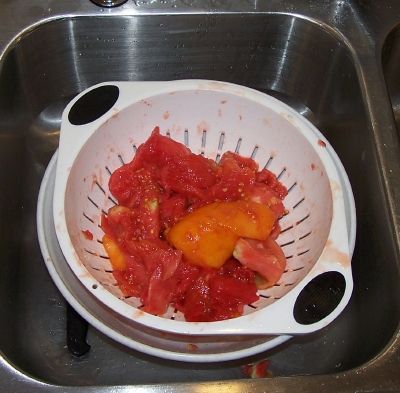Looking for How to quickly and easily skin tomatoes in 2025? Scroll down this page and follow the links. And if you bring home some fruit or vegetables and want to can, freeze, make jam, salsa or pickles, see this page for simple, reliable, illustrated canning, freezing or preserving directions. There are plenty of other related resources, click on the resources dropdown above. If you are having a hard time finding canning lids, I've used these, and they're a great price & ship in 2 days.
If you have questions or feedback, please let me know! There are affiliate links on this page. Read our disclosure policy to learn more.
How to quickly and easily skin tomatoes
 How to
quickly and easily skin tomatoes !
How to
quickly and easily skin tomatoes !
Click here for a PDF print version
If you need skinned tomatoes to use in a salad or recipe, here's the simple way to do. This is particularly useful late in the season when the skins of tomatoes tend to become tough and unattractive due cold, extreme heat, bugs, etc.
This method is so easy, ANYONE can do this! It's a great thing to do with your kids! Also, this recipe/directions works with either red (ripe) or green (unripe tomatoes).
If you have a Pressure Canner, you may want to see the pressure canning tomatoes page!
These pages may also interest you:
- How to make tomato sauce
- How to make tomato paste
- And if you'd like to start you own tomatoes from seed (you can save a
small fortune and grow the heirloom varieties you like)
see this page for easy directions for growing your own tomato plants from seed.
Ingredients
- Tomatoes - about 20 lbs to make 7 quarts (7 large tomatoes will fill one quart jar.)
Equipment
- 1 large pot with boiling water (to scald the tomatoes, step 3)
- Ice and a large bowl or pot
- Large spoons and ladles,
How to quickly and easily skin tomatoes
 Step
1 - Removing the tomato skins
Step
1 - Removing the tomato skins
Here's a trick you may not know: put the tomatoes, a few at a time in a large pot of boiling water for no more than 1 minute (30 - 45 seconds is usually enough)
- Dead ripe tomatoes - take only 20 - 30 seconds in boiling water
- Ripe tomatoes - about 30 - 40 seconds
- Slightly unripe tomatoes - about 1 minute in the boiling water
Step 2 - Remove and immerse in the ice water
Plunge them into a waiting bowl of ice water.
This makes the skins slide right off of the tomatoes! If you leave the skins in, they become tough and chewy in the sauce, not very pleasant.
Step 3 - Removing the skins, bruises and tough parts
The skins should practically slide off the tomatoes. then you can cut the tomatoes in quarters and remove the tough part around the stem and any bruised or soft parts.
Step 4 - Squeeze of the seeds and water
Just like it sounds: wash your hands then squeeze each tomato and use your finger or a spoon to scoop and shake out most of the seeds. You don't need to get fanatical about it; removing just most will do. Another way to do it is to cut each tomato in half, across it, instead of lengthwise. Then just shake the seeds and juice out. Here are before and after photos: Of course, you can save the juice to use as tomato juice!


Step 5 - Drain the tomatoes
 Toss
the squeezed (Squozen? :) tomatoes into a colander or drainer, while you
work on others. This helps more of the water to drain off. You may
want to save the liquid: if you then pass it through a sieve, screen or
cheesecloth, you have fresh tomato juice; great to drink cold or use in
cooking! By draining the water off now, you will end up with a
thicker spaghetti sauce in less cooking time! And that preserves vitamins
(and your sanity).
Toss
the squeezed (Squozen? :) tomatoes into a colander or drainer, while you
work on others. This helps more of the water to drain off. You may
want to save the liquid: if you then pass it through a sieve, screen or
cheesecloth, you have fresh tomato juice; great to drink cold or use in
cooking! By draining the water off now, you will end up with a
thicker spaghetti sauce in less cooking time! And that preserves vitamins
(and your sanity).
Frequently Asked Questions about Canning Tomatoes
Why do my tomatoes separate from the liquid?
A frequent problem is the separation of water from the tomatoes. Why does the water separate from the solids in tomatoes?
Scenario 1 - liquid at the top and solids at the bottom
Home canned tomatoes, tomato juice, and tomato sauces with liquid at the top and solids at the bottom is quite normal. It only reflects that the juice was made prior to heating. For example, the tomatoes were chopped, run through the steamer, sieve, or food mill while still raw and prior to heating.
As soon as they are chopped or crushed, enzymes start to break down the pectin that helps to hold tomato cells together. The enzyme that causes separation is activated by exposure to air and inactivated by heat. In commercial production, tomatoes are flash heated nearly to boiling in a matter of seconds, using equipment not available to consumers. Because the pectin holding tomato cells together is not exposed to air when cold, it remains intact, and a thick bodied, homogeneous juice is produced.
The solution is to leave tomatoes whole or in large chunks (do not chop). Heat before chopping or juicing to minimize the separation.
The best way to do that at home is to heat quartered tomatoes quickly to boiling temperatures WHILE crushing. You can also heat the blanched, peeled whole tomatoes in the microwave, then crush them!
Make sure the mixture boils constantly and vigorously while you add the remaining tomatoes. Simmer 5 minutes after all tomatoes are added, before juicing. If you are not concerned about juice separating, simply slice or quarter tomatoes into a large saucepan. Crush, heat and simmer for 5 minutes before juicing.
Scenario 2 - liquid at the bottom and solids at the top (note the photo is step 10)
What about the reverse: liquid at the bottom and solids at the top? That indicates too much preheating (more than 5 minutes). Pectin breaks down when it is overheated; then separation results. If separation occurs, just shake the jar before opening or decant the water off.
References: Ohio State University
I recently canned tomatoes but had one little jar that I didn't have room for in the water bath. So I decided to just refrigerate it. All I've done to those tomatoes is blanch them -- haven't cooked them, stewed them, done anything else. There is some lemon juice in them. They've been refrigerated since I packed them -- how long will they be okay to use?
They will last about the same length of time that a can of tomatoes from the grocery store will last once you open it an put it in the fridge. I'd guess a couple of weeks, but that depends on how cold your fridge is.
After I removed the jars of tomatoes from the canner, the jars had lost a lot of liquid and were about half-empty. What happened? Are they safe?
There are several possible causes:
- The food was not heated prior to filling (Raw pack method) -
- The food was packed too tightly (or loosely) in the jars
- All air bubbles were not removed prior to sealing the lids and rings on the jars
- The jars were not completely covered with water (applies to a water bath canner only)
- Starchy foods, such as corn, peas or lima beans, absorbed all the liquid. Use more liquid with these starchy vegetables.
- The jars were filled too full.
- Fluctuating pressure in the pressure canner. Let pressure return to zero gradually, avoiding the sudden release of pressure through the vent. Do not hasten the cooling with cold water.
As long as the jars remained sealed, they will be ok, but they should be checked more frequently and used up first!
What did I do wrong if my jars spoil?
Tomatoes are a borderline acid / low acid fruit (see this page about tomato acidity for more information) - adding lemon juice helps, processing at least 35 minutes in the water bath canner, or better still, using a Pressure Canner almost eliminates spoilage. If you don't have a pressure canner, you must boost the acid level of the sauce, by adding 2 tablespoons of lemon juice or 1/2 teaspoon of citric acid per quart of sauce.
Other Equipment:
|
From left to right:
|
Canning kit with Stainless Steel Steam Rack,Canning Funnel, Jar Lifter, Jar Wrench, Lid Lifter, Canning Tongs, Bubble Remover Tool |
 |
| McSunley 21.5 quart Water Bath Canner, Stainless Steel Granite Ware 21 QT, 9 Piece Enamelware Water bath Canning Pot with Canning kit, Colander and Rack VKP Brands Water Bath AND Steam Canner, 20 Quart Stainless Steel, flat-bottomed Induction range compatible and safe for smooth top ranges. 
|
Home Canning KitsThis is the same type of standard canner that my grandmother used
to make everything from applesauce to jams and jellies to tomato and
spaghetti sauce. This complete kit includes everything you need and lasts
for years: the canner, jar rack, Jar grabber tongs, lid lifting wand, a
plastic funnel, labels, bubble freer, and the bible of canning, the Ball
Blue Book. It's much cheaper than buying the items separately. you will never need anything else except jars & lids! To see more canners, of different styles, makes and prices, click here!For
more information and current pricing: |
Summary - Cost of Making Homemade Canned Tomatoes - makes 7 quart jars, 32 oz each* |
||||
| Item | Quantity | Cost in 2025 | Source | Subtotal |
| Tomatoes | 20 - 25 lbs (to make about 16 cups of prepared tomato) | free from the garden, or $0.75 cents at a PYO | Garden | $0.00 |
| Canning jars (quart size, wide mouth), includes lids and rings | 7 jars | $8.00/dozen | Grocery stores, like Publix, Kroger and Safeway and local "big box" stores; sometimes Big Lots and even hardware stores | $4.50 |
| Lemon juice | 14 Tablespoons | $0.50 | Grocery store | $0.50 |
| Total | $5.00 total or about $0.72 per jar INCLUDING the jars - which you can reuse! |
|||
| * - This assumes you already have the pots, pans, ladles,, and reusable equipment. Note that you can reuse the jars! Many products are sold in jars that will take the lids and rings for canning. For example, Classico Spaghetti sauce is in quart sized jars that work with Ball and Kerr lids and rings. Note that the Classico's manufacturer does not recommend reuse of their jars: see what they have to say on this page. | ||||
Looking for canning equipment and supplies?
Water bath canner with a jar rack
Pressure canners for gas, electric and induction stoves: Presto 23Qt or T-fal 22Qt
Canning scoop (this one is PERFECT)
Ball Blue book (most recent version)
Jars: 8oz canning jars for jams
Find Other types of farms:
Farm markets and roadside stands
Road trips and camping resources
Local Honey, apiaries, beekeepers
Consumer fraud and scams information
Home canning supplies at the best prices on the internet!
Maple Syrup Farms, sugarworks, maple syrup festivals
Environmental information and resources
Farms For Your Event for birthday parties, weddings, receptions, business meetings, retreats, etc.
Festivals - local fruit and vegetable festivals
Get the
most recent version of
the Ball Blue Book
With this Presto 23 quart pressure canner and pressure cooker, you can "can" everything, fruits, vegetables, jams, jellies, salsa, applesauce, pickles, even meats, soups, stews. Model 01781

You can make jams, jellies, can fruit, applesauce, salsa and pickles with water bath canners, like this Granite Ware 12-Piece Canner Kit, Jar Rack, Blancher, Colander and 5 piece Canning Tool Set

